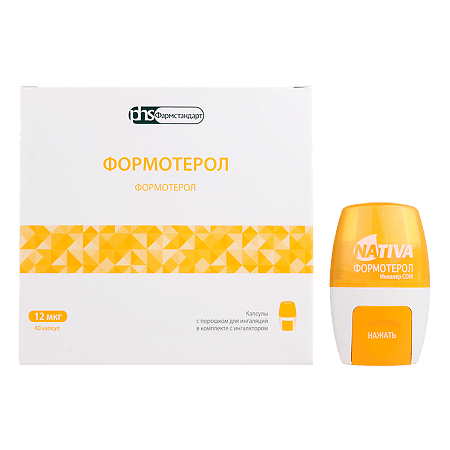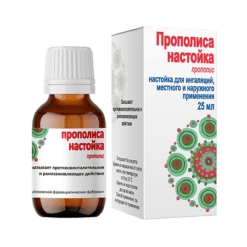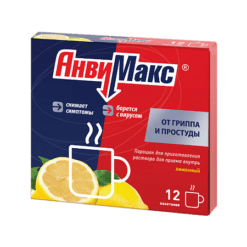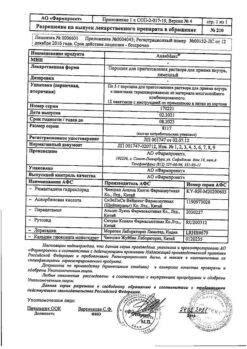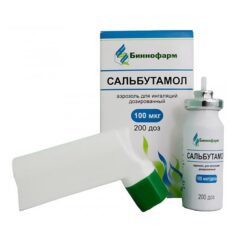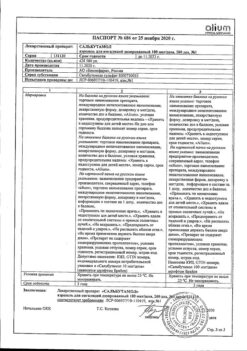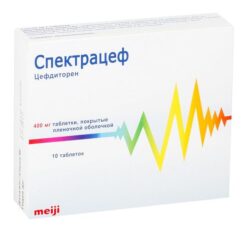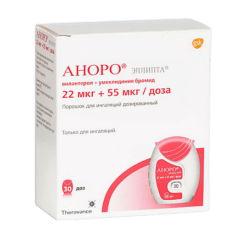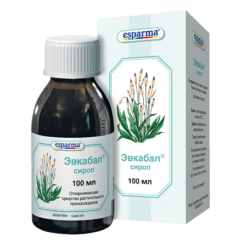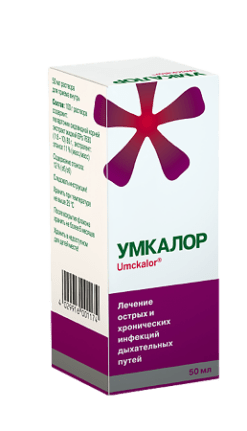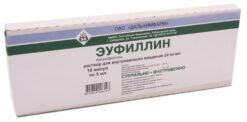No products in the cart.
Formoterol, 12 mcg/dose 60 pcs
€1.00
Out of stock
(E-mail when Stock is available)
Description
Pharmacotherapeutic group
Bronchodilator agent – β2-adrenomimetic selective
ATC code
R03AC
Pharmacodynamics:
Formoterol is a selective beta2-adrenoreceptor agonist (beta2-adrenomimetic). It has a bronchodilator effect in patients with reversible airway obstruction. The action of the drug comes quickly (within 1-3 minutes) and lasts for 12 hours after inhalation. When using therapeutic doses, the effect on the cardiovascular system is minimal and only rarely observed.
Formoterol inhibits the release of histamine and leukotrysin from mast cells. In animal experiments some anti-inflammatory properties of formoterol have been shown, such as the ability to inhibit the development of edema and accumulation of inflammatory cells.
In in vitro animal experiments, racemic formoterol and its (R.R) and (S.S) enantiomers have been shown to be highly selective beta2 receptor agonists. The (S.S) enantiomer was 800-1000 times less active than the (RR) enantiomer and had no adverse effect on the activity of the (R.R) enantiomer with respect to effects on tracheal smooth muscle. There was no pharmacological evidence of an advantage of using one of these two enantiomers over the racemic mixture.
In studies in humans, formoterol has been shown to effectively prevent bronchospasm induced by inhaled allergens from physical activity with cold air histamine or methacholine. Since the bronchodilator effect of formoterol remains pronounced for 12 hours after inhalation, its administration 2 times a day for long-term maintenance therapy can in most cases provide the necessary control of bronchospasm in chronic lung diseases both during the day and at night.
In patients with stable chronic obstructive pulmonary disease (COPD) formoterol used as inhaled doses of 12 or 24 mcg twice daily is accompanied by improvement in quality of life parameters.
Pharmacokinetics:
Therapeutic dose range of formoterol is from 12 mcg to 24 mcg 2 times daily. Formoterol pharmacokinetic data were obtained in healthy volunteers after inhalation of formoterol at doses above the recommended range and in COPD patients after inhalation of formoterol at therapeutic doses.
Introduction
After a single inhalation of formoterol at a dose of 120 mcg in healthy volunteers, formoterol is rapidly absorbed into the blood plasma with a maximum plasma concentration (Cmax) of 266 pmol/L, reached within 5 minutes of inhalation. In COPD patients receiving formoterol at a dose of 12 or 24 micrograms twice daily for 12 weeks, the plasma concentrations of formoterol measured 10 minutes to 2 hours and 6 hours after inhalation were in the ranges of 115-257 lmol/L and 233-503 pmol/L, respectively.
Studies investigating the total urinary excretion of formoterol and its (R.R) and (S.S) enantiomers have shown that the amount of formoterol in the systemic bloodstream increases in proportion to the inhaled dose (12-96 µg).
After inhaled use of formoterol at a dose of 12 or 24 mcg twice daily for 12 weeks, urinary excretion of unchanged formoterol increased by 63-73% in patients with bronchial asthma (BA) and by 19-38% in patients with COPD. This indicates some cumulation of formoterol in blood plasma after repeated inhalations. No greater cumulation of one formoterol enantiomer than the other was observed after repeated inhalations.
The majority of formoterol administered by inhaler is swallowed and then absorbed from the gastrointestinal (GI) tract. When 80 μg of 3H-labeled formoterol was administered orally to two healthy volunteers, at least 65% of formoterol was absorbed.
Distribution
The binding of formoterol to plasma proteins is 61-64% binding to serum albumin is 34%. Saturation of binding sites is not achieved in the range of concentrations observed after administration of therapeutic doses of the drug.
Metabolism
The main route of metabolism of formoterol is direct conjugation with glucuronic acid. Another way of metabolism is O-demethylation with subsequent conjugation to glucuronic acid (glucuronidation).
Small metabolic pathways include conjugation of formoterol with sulfate followed by deformylation. Multiple isoenzymes are involved in the processes of glucuronidation (UGT1A1 1AZ 1A6 1A7 1A8 1A9 1A10 2B7 and 2B15) and O-demethylation (CYP2D6 209 2C9 and 2A6) of formoterol, which suggests a low possibility of drug interaction through inhibition of any isoenzyme involved in formoterol metabolism. At therapeutic concentrations, formoterol does not inhibit cytochrome P450 isoenzymes.
When formoterol is taken in a dose of 12 or 24 mcg 2 times daily for 12 weeks, 10 % and 15-18 % of the total dose in AD patients are excreted unchanged in the urine; 7 % and 6-9 % of the total dose in COPD patients, respectively.
The calculated urinary fractions (RR) and (SS) of unchanged formoterol enantiomers are 40% and 60%, respectively, after a single dose of formoterol (12-120 >1kg) in healthy volunteers and after single and repeated doses of formoterol in AD patients.
The active ingredient and its metabolites are completely eliminated from the body; about 2/3 of the orally administered dose is excreted with the urine 1/3 with the feces. Renal clearance of formoterol is 150 ml/min.
In healthy volunteers, the final half-life of formoterol from plasma after a single inhalation of formoterol 120 mcg is 10 hours; the final half-lives (RR) and (SS) of enantiomers calculated from urinary excretion are 139 and 123 hours, respectively.
Pharmacokinetics in selected patient groups
Performoterol pharmacokinetic parameters in men and women are not significantly different after adjustment for body weight.
Elderly patients (older than 65 years)
There is no evidence to support the need to change formoterol dosing in patients older than 65 years compared to younger patients.
Patients with hepatic and/or renal impairment
Pharmacokinetics of formoterol in patients with hepatic and/or renal impairment have not been studied.
Indications
Indications
Prevention and treatment of bronchial obstruction in patients with bronchial asthma (BA) as an addition to therapy with inhaled glucocorticosteroids.
Prevention of bronchospasm caused by inhalation of allergens by cold air or physical activity as an addition to therapy with inhaled glucocorticosteroids.
Prevention and treatment of bronchial obstruction in patients with chronic obstructive pulmonary disease (COPD) in the presence of both reversible and irreversible bronchial obstruction, chronic bronchitis and emphysema.
Pharmacological effect
Pharmacological effect
Pharmacotherapeutic group
bronchodilator – selective β2 adrenergic agonist
ATX code
R03AC
Pharmacodynamics:
Formoterol is a selective beta2-adrenergic receptor agonist (beta2-adrenergic agonist). It has a bronchodilator effect in patients with reversible airway obstruction. The effect of the drug occurs quickly (within 1-3 minutes) and lasts for 12 hours after inhalation. When using therapeutic doses, the effect on the cardiovascular system is minimal and is observed only in rare cases.
Formoterol inhibits the release of histamine and leukotrisins from mast cells. Animal experiments have shown some anti-inflammatory properties of formoterol, such as the ability to prevent the development of edema and the accumulation of inflammatory cells.
In vitro animal studies have shown that racemic formoterol and its (R.R) and (S.S) enantiomers are highly selective beta2 receptor agonists. The (S.S) enantiomer was 800-1000 times less active than the (RR) enantiomer and did not adversely affect the activity of the (R.R) enantiomer in affecting tracheal smooth muscle. There has been no pharmacological evidence of benefit from using one of these two enantiomers over the racemic mixture.
Studies in humans have shown that formoterol effectively prevents bronchospasm caused by inhaled allergens, physical exercise, cold air, histamine or methacholine. Since the bronchodilator effect of formoterol remains pronounced for 12 hours after inhalation, prescribing the drug 2 times a day for long-term maintenance therapy allows, in most cases, to provide the necessary control of bronchospasm in chronic lung diseases both during the day and at night.
In patients with chronic obstructive pulmonary disease (COPD) with a stable course, formoterol used in the form of inhalations in doses of 12 or 24 mcg 2 times a day is accompanied by an improvement in quality of life parameters.
Pharmacokinetics:
The therapeutic dose range for formoterol is 12 mcg to 24 mcg twice daily. Data on the pharmacokinetics of formoterol were obtained in healthy volunteers after inhalation of formoterol in doses above the recommended range and in patients with COPD after inhalation of formoterol in therapeutic doses.
Suction
After a single inhalation of formoterol at a dose of 120 mcg to healthy volunteers, formoterol is rapidly absorbed into the blood plasma; the maximum concentration of formoterol in blood plasma (Cmax) is 266 pmol/l and is achieved within 5 minutes after inhalation. In patients with COPD. receiving formoterol at a dose of 12 or 24 mcg 2 times a day for 12 weeks, formoterol plasma concentrations measured 10 minutes, 2 hours and 6 hours after inhalation were in the ranges of 115-257 lmol/l and 233-503 pmol/l, respectively.
In studies that examined the total excretion of formoterol and its (R.R) and (S.S) enantiomers in urine, it was shown that the amount of formoterol in the systemic circulation increases in proportion to the size of the inhaled dose (12-96 mcg).
After inhaled use of formoterol at a dose of 12 or 24 mcg 2 times a day for 12 weeks, the excretion of unchanged formoterol in the urine in patients with bronchial asthma (BA) increased by 63-73% and in patients with COPD – by 19-38%. This indicates some accumulation of formoterol in the blood plasma after repeated inhalations. However, there was no greater accumulation of one of the enantiomers of formoterol compared to the other after repeated inhalations.
Most of formoterol administered by inhaler is swallowed and then absorbed from the gastrointestinal tract (GIT). When 80 mcg of 3H-labeled formoterol was administered orally to two healthy volunteers, at least 65% of the formoterol was absorbed.
Distribution
The binding of formoterol to plasma proteins is 61-64%; binding to serum albumin is 34%. In the concentration range observed after the use of therapeutic doses of the drug, saturation of binding sites is not achieved.
Metabolism
The main route of metabolism of formoterol is direct conjugation with glucuronic acid. Another metabolic pathway is O-demethylation followed by conjugation with glucuronic acid (glucuronidation).
Minor metabolic pathways include conjugation of formoterol with sulfate followed by deformylation. Many isoenzymes are involved in the processes of glucuronidation (UGT1A1 1AZ 1A6 1A7 1A8 1A9 1A10 2B7 and 2B15) and O-demethylation (CYP2D6 209 2C9 and 2A6) of formoterol, which suggests a low probability of drug interaction through inhibition of any isoenzyme involved in metabolism formoterol. At therapeutic concentrations, formoterol does not inhibit isoenzymes of the cytochrome P450 system.
Removal
When taking formoterol in a dose of 12 or 24 mcg 2 times a day for 12 weeks, 10% and 15-18% of the total dose are excreted unchanged in the urine in patients with asthma; 7% and 6-9% of the total dose, respectively, in patients with COPD.
The calculated proportions (RR) and (SS) of enantiomers of unchanged formoterol in urine are 40% and 60%, respectively, after a single dose of formoterol (12-120 >1 kg) in healthy volunteers and after single and repeated doses of formoterol in patients with asthma.
The active substance and its metabolites are completely eliminated from the body; about 2/3 of the dose administered orally is excreted in the urine and 1/3 in feces. The renal clearance of formoterol is 150 ml/min.
In healthy volunteers, the terminal half-life of formoterol from plasma after a single inhalation of formoterol at a dose of 120 mcg is 10 hours; the terminal half-lives (RR) and (SS) of the enantiomers calculated from urinary excretion are 139 and 123 hours, respectively.
Pharmacokinetics in selected patient groups
Floor
After adjustment for body weight, the pharmacokinetic parameters of formoterol in men and women do not differ significantly.
Elderly patients (over 65 years old)
There is no evidence to support the need to change the dosage of formoterol in patients over 65 years of age compared with younger patients.
Patients with impaired liver and/or kidney function
The pharmacokinetics of formoterol in patients with impaired liver and/or renal function have not been studied.
Special instructions
Special instructions
Anti-inflammatory therapy In patients with bronchial asthma, native formoterol should be used only as an additional treatment in case of insufficient control of symptoms during monotherapy with inhaled corticosteroids or in severe forms of the disease requiring the use of a combination of inhaled corticosteroids and a long-acting beta2-adreceptor agonist. Formoterol native should not be used with other long-acting beta2-adrenergic receptor agonists.
When prescribing the drug Formoterol-native, it is necessary to assess the condition of patients regarding the adequacy of the anti-inflammatory therapy they receive. After starting treatment with Formoterol-native, patients should be advised to continue anti-inflammatory therapy without changes, even if improvement is noted.
To relieve an acute attack of bronchial asthma, beta2-adrenergic receptor agonists should be used. If the condition suddenly worsens, patients should seek medical help immediately.
Hypokalemia
A consequence of therapy with beta2-agonists, including Formoterol-native, may be the development of potentially serious hypokalemia. Hypokalemia may increase the risk of developing arrhythmias. Since this effect of the drug Formoterol-native can be enhanced by hypoxia and concomitant treatment, special caution should be observed in patients with severe bronchial asthma. In these cases, regular monitoring of serum potassium concentration is recommended.
Paradoxical bronchospasm
Like other inhaled drugs, Formoterol native can cause paradoxical bronchospasm. In this case, the drug should be discontinued immediately and alternative treatment should be prescribed.
The use of formoterol in a dose exceeding 54 mcg/day (more than 4 inhalations) may lead to positive results in doping tests.
Impact on the ability to drive vehicles. Wed and fur.:
There are no data on the effect of the drug Formoterol-pativ on the ability to drive vehicles and operate machinery. In the event of the development of such adverse reactions as dizziness, tremor, cramps or muscle spasms, it is necessary to refrain from driving vehicles and operating machinery, as well as from engaging in other potentially hazardous activities that require increased concentration and speed of psychomotor reactions.
Active ingredient
Active ingredient
Formoterol
Composition
Composition
Active substance: Formoterol fumarate dihydrate 12 mcg
Excipients:
Sodium benzoate 0.02 mg
Lactose monohydrate up to 12 mg
Capsule:
Caramel coloring (E 150c) 1.4388%
Hypromellose up to 100%
Pregnancy
Pregnancy
The safety of formoterol during pregnancy and breastfeeding has not yet been established.
Use during pregnancy is possible only if the expected benefit to the mother outweighs the potential risk to the fetus. Formoterol, like other beta2-agonists, can slow down the process of labor due to its tocolytic effect (relaxing effect on the smooth muscles of the uterus).
It is unknown whether formoterol passes into breast milk. Therefore, if it is necessary to use formoterol, breastfeeding should be stopped.
There is no data on the effect of the drug on fertility. Studies in experimental animals have shown no effect on fertility with oral formoterol.
Contraindications
Contraindications
Hypersensitivity and/or intolerance to any of the components of the drug.
Age up to 18 years.
Breastfeeding.
Rare hereditary diseases such as lactose intolerance, lactase deficiency or glucose-galactose malabsorption.
With caution:
If you have one of the listed diseases, be sure to consult your doctor before using the drug.
Particular caution when using the drug Formoterol-native (especially in terms of dose reduction) and careful monitoring of patients is required in the presence of the following concomitant diseases: coronary heart disease; disturbances of heart rhythm and conduction, especially third degree atrioventricular block; severe heart failure; idiomatic hypertrophic subaortic stenosis; severe arterial hypertension; aneurysm of any location; phsochromocytoma; ketoacidosis; hypertrophic obstructive cardiomyopathy; thyrotoxicosis; known or suspected prolongation of the QTc interval (QT corrected > 0.44 sec);
Considering the hyperglycemic effect characteristic of β2-adrenergic agonists in patients with diabetes mellitus taking Formoterol-native, additional regular monitoring of blood glucose concentration is recommended.
Side Effects
Side Effects
Adverse reactions are distributed according to frequency of occurrence. The following criteria were used to assess the frequency: very often (>1/10) often (from 1/100 to 1/10) infrequently (from 1/1000 to 1/100) rarely (from 1/10000 to 1/1000) very rarely (<1/10000) (including individual reports).
Infectious and parasitic diseases: often – pharyngitis, acute respiratory viral infection.
Immune system disorders: very rarely – anaphylactic reactions, urticaria, angioedema (Quincke’s edema), itching, rash.
Metabolic and nutritional disorders: very rarely – metabolic acidosis. Mental disorders: infrequently – agitation, anxiety, increased excitability, insomnia; very rarely – increased fatigue.
Nervous system disorders: often – headache, tremor; infrequently – dizziness; very rarely – a change in taste sensations.
Cardiac disorders: often – palpitations, chest pain; infrequently – tachycardia; very rarely – peripheral edema; angina pectoris, cardiac arrhythmia (including atrial fibrillation, ventricular extrasystoles, tachyarrhythmia).
Vascular disorders: very rarely – decreased blood pressure (hypotension), increased blood pressure (hypertension).
Disorders of the respiratory system of the chest and mediastinum: often – sinusitis, increased sputum production; uncommon – bronchospasm including paradoxical dysphonia; very rarely – cough.
Gastrointestinal disorders: infrequently – dryness of the oral mucosa; very rarely – nausea.
Musculoskeletal and connective tissue disorders: often – back pain, leg cramps; infrequently – muscle spasm myalgia.
General disorders and disorders at the injection site: often – fever; infrequently – irritation of the mucous membrane of the pharynx and larynx.
Laboratory and instrumental data: uncommon – flattening or inversion of the T wave, depression of the ST segment, prolongation of the QT interval on the electrocardiogram; very rarely – hypokalemia, hyperglycemia.
If any of the adverse reactions indicated in the instructions worsen or you notice any other adverse reactions not listed in the instructions, please inform your doctor.
Interaction
Interaction
The drug Formoterol-native, as well as other beta2-agonists, should be prescribed with caution to patients receiving drugs such as: quinidine disopyramide procainamide phenothiazines macrolides monoamine oxidase inhibitors (MAO) tricyclic antidepressants antihistamines and other drugs that are known to prolong the QT interval since in these cases the effect of adrenal stimulants on the cardiovascular system may be enhanced and the risk of ventricular arrhythmias increases. The simultaneous use of other sympathomimetic drugs may lead to aggravation of adverse reactions of the drug Formoterol-native.
Concomitant use of xanthine derivatives, glucocorticosteroids or diuretics may enhance the potential hypokalemic effect of Formoterol-native.
Patients receiving anesthesia using halogenated hydrocarbons have an increased risk of developing arrhythmias.
Drugs related to beta2-blockers can weaken the effect of Formoterol-native and lead to serious bronchospasm in patients with bronchial asthma. In this regard, the drug Formoterol-native should not be used together with beta2-blockers (including eye drops) unless the use of such a combination of drugs is forced by any emergency reasons.
Overdose
Overdose
Symptoms. An overdose of formoterol can likely lead to the development of phenomena characteristic of an overdose of beta2-adrenergic agonists or an increase in the manifestation of side effects: chest pain, palpitations, tachycardia up to 200 beats per minute, ventricular arrhythmias, increased or decreased blood pressure, dry mouth, nausea, vomiting, headache, dizziness, tremor, nervousness, weakness, anxiety, drowsiness, metabolic acidosis, hypokalemia, hyperglycemia convulsions. As with all inhaled beta2-agonists, an overdose of formoterol can cause cardiac arrest and death.
Treatment. Maintenance and symptomatic therapy is indicated. In serious cases, hospitalization is necessary.
The use of cardioselective beta2-blockers may be considered. but only under close medical supervision and with extreme caution, since the use of such drugs can cause bronchospasm. Monitoring of cardiac indicators is recommended.
Storage conditions
Storage conditions
In a place protected from light at a temperature not exceeding 25°C.
Keep out of the reach of children.
Shelf life
Shelf life
2 years. Do not use after the expiration date indicated on the package.
Manufacturer
Manufacturer
Pharmstandard-Leksredstva, Russia
Additional information
| Shelf life | 2 years. Do not use after the expiration date stated on the package. |
|---|---|
| Conditions of storage | In the dark place at a temperature not exceeding 25°C. Store out of the reach of children. |
| Manufacturer | Pharmstandard-Leksredstva, Russia |
| Medication form | capsules with powder for inhalation |
| Brand | Pharmstandard-Leksredstva |
Related products
Buy Formoterol, 12 mcg/dose 60 pcs with delivery to USA, UK, Europe and over 120 other countries.

